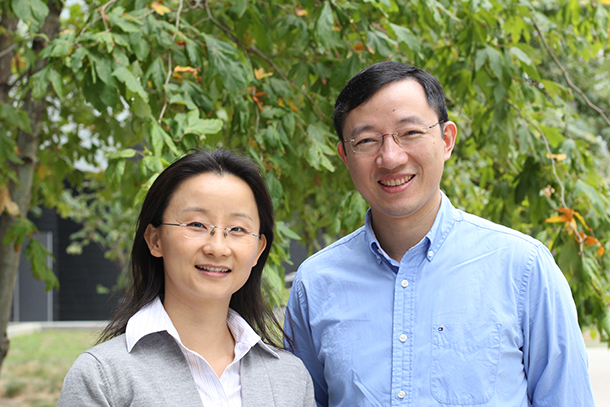Riddle me this: how do you get stem cells to thrive outside of their natural environment?
According to Keyue Shen, PhD, if all else fails, you can always trick them — with artificially engineered neighbor cells.
Shen, an assistant professor of biomedical engineering at the USC Viterbi School of Engineering, and Rong Lu, PhD, an assistant professor of stem cell biology and regenerative medicine at the Keck School of Medicine of USC, recently won a National Institutes of Health (NIH) R21 Trailblazer Award from the National Institute of Biomedical Imaging and Bioengineering (NIBIB). They were selected for their early-stage investigation to expand healthy stem cells ex vivo, or outside of the body.
The Motherlode
Shen, principal investigator, and Lu, co-investigator, focused on hematopoietic stem cells (HSCs) which Shen refers to as “the mother of all blood cells, essentially.” HSCs are attractive for stem-cell based therapies since they rapidly expand and form all types of blood cells after in vivo (inside the body) transplantation.
HSCs are also used for diseases that require new blood and immune cells, like cancers. During cancer treatment, radiation and chemotherapy may destroy blood cells, which are required for a healthy immune system. Essentially, a fresh supply of HSCs can help the cancer patient recover their whole blood system, Lu said.
However, the current method of giving patients new HSCs via bone marrow transplantation is not ideal.
“Basically, it’s hard to find a donor match, and it’s also hard to culture HSCs outside of the body,” Shen said. “If you don’t transplant enough HSCs from donors, the procedure might fail because these cells do suffer loss during the transplant process. But that means that you take a lot of bone marrow from the donor and sometimes that causes clinical problems. The logistics are really hard.”
Old Problem, New Approach
Shen stresses that an optimal way to harvest HSCs would be through an engineered approach which could produce a large population of cells. The HSCs could be cryopreserved, or frozen down in vials surrounded by liquid nitrogen, and managed using a database to find a patient’s genetic match. Then, they could be transplanted via injection just like a vial drug.
“I am really excited that we get into an old question from a new approach, which is the engineering approach,” Lu said.
Lu refers to the fact that HSCs aren’t easily expanded in cell cultures as a “long-standing problem.”
“The issue is that HSCs are very hard to store and will lose their identity if you put them in culture for more than a couple of days,” Lu said. “In vitro is still not a good method.”
By “losing their identity,” Lu means that the HSCs will lose their ability to do their job – to make more and more blood cells – when outside of the body.
“HSCs don’t like the in-vitro environment at all,” Shen said. “We want to find out why they don’t like it and what kind of environment they really like, so we can recapitulate and recreate that kind of environment outside of the body.”
Shen believes the answer to successful ex vivo growth for HSCs lies in looking at the cells in the context of neighbor cells, called stromal cells. The stromal cells interact with the HSCs, delivering essential signals that are required for maintaining the HSCs’ properties. In addition to signal delivery, stromal cells recruit cells that attach to their surface, creating unique ways that their cell receptors work with each other.
“We want to see the details, know the details of how these receptors interact with each other and how these surface bound signals work together with say, soluble factors secreted from stromal cells to the HSCs,” Shen said. “So, multiple factors combined together, we think that might be the key to successful HSC expansion.”
To accomplish this, Shen and Lu are engineering different kinds of artificial stromal cells to trick the HSCs into thinking they are still in their natural environment. By mimicking the spatial organization of the receptors on these interlopers, the HSCs will receive signals from the dupes just like they would from real stromal cells.
“So, it’s very much like they see those artificial cells; it’s almost like seeing a real cell,” Shen said. “The engineered stromal cells trick the HSCs, so they don’t lose their identity and don’t forget to know what to do.”
Onward, Scientists
The duo will continue this research with the NIH Trailblazer R21 Award, which provides $400,000 in direct costs over the next three years.
“I think the exciting part for me, as an engineer, is that we’re making something possible that was impossible in the past,” Shen said. “To help the patients.”
— Breanne Grady


